
Journal Menu
► ▼ Journal Menu-
- Gels Home
- Aims & Scope
- Editorial Board
- Reviewer Board
- Topical Advisory Panel
- Instructions for Authors
- Special Issues
- Topics
- Sections & Collections
- Article Processing Charge
- Indexing & Archiving
- Editor’s Choice Articles
- Most Cited & Viewed
- Journal Statistics
- Journal History
- Journal Awards
- Conferences
- Editorial Office
- 10th Anniversary
Journal Browser
► ▼ Journal BrowserNeed Help?
Announcements
4 November 2022
Gels 2022 Travel Award—Winner Announced
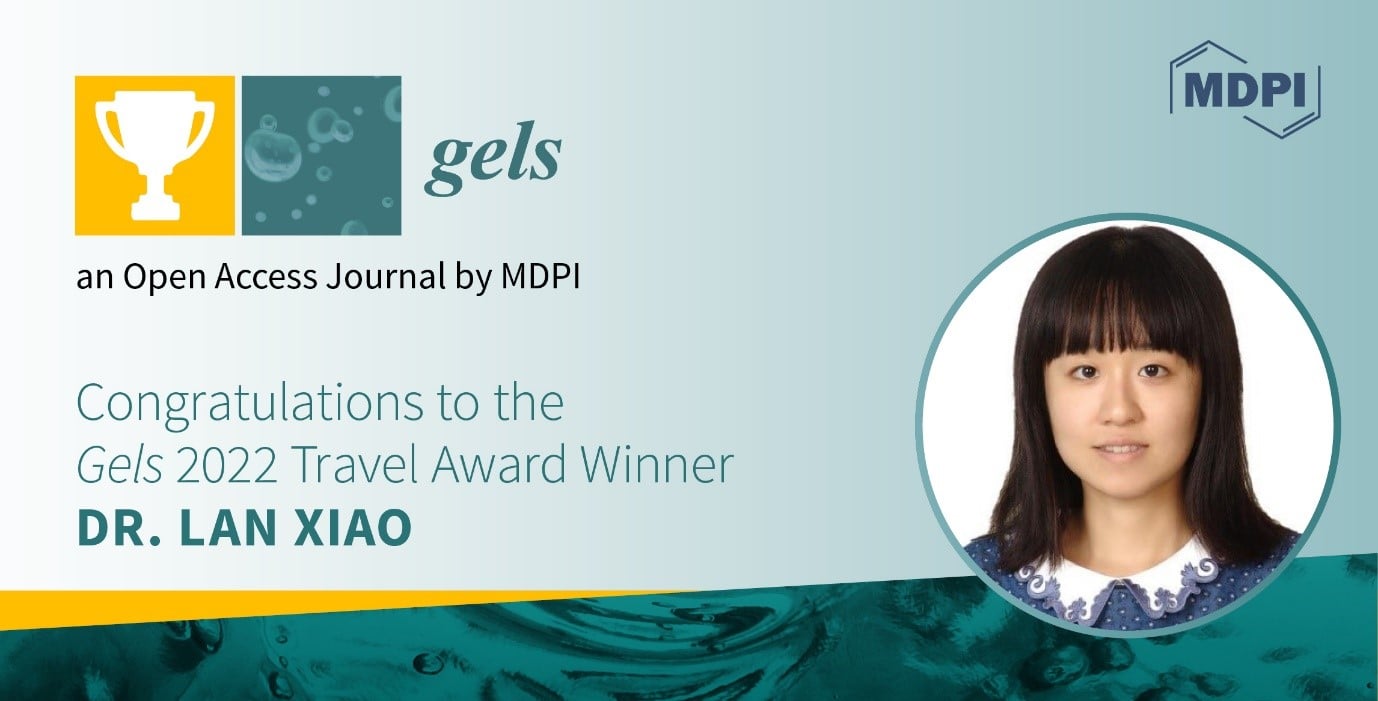
We are pleased to announce the winner of the Gels 2022 Travel Award. The award has been granted to Dr. Lan Xiao, a postdoctoral researcher in the School of Mechanical, Medical and Process Engineering, Queensland University of Technology, Australia.
Dr. Lan Xiao is an outstanding early career researcher in tissue engineering and regenerative medicine. Her research mainly focuses on developing potential therapeutic approaches to induce/improve tissue regeneration (e.g., bone regeneration, neuronal regeneration, wound healing, and vascular regeneration) by modulating the immune system to ensure the local environment is beneficial for regeneration. She has 47 published journal papers, including those in top journals such as Materials today (IF: 31.041), Nano letters (IF: 11.238), Advanced Functional Materials (IF: 18.808), Advanced Science (IF: 16.806), Autophagy (IF: 16.016), Chemical Engineering (IF: 13.273), and Acta Pharmaceutica Sinica B (IF: 11.413). Her publications have been cited 11320 times with a H-index of 16 (Google scholar), and 55.6% of them were published in the top 10% journals worldwide, which is significantly above the average as indicated by her FWCI of 6.38 (SciVal). This includes an international collaborative (88.9% of them were co-authored with researchers in foreign countries/regions) and cross-disciplinary reach (10 research areas including medicine, engineering and material science; SciVal). She has co-supervised six HDR students and three visiting-scholars, co-led multiple national and international projects (contributed to 23 papers), and attracted $117,321 CI funding (CIA: $67,321).
As the awardee, Dr. Lan Xiao will receive an honorarium of CHF 500 and an electronic certificate.
We would like to thank all the applicants for submitting their diverse and fascinating range of research topics.
Prof. Dr. David Díaz Díaz
Editor-in-Chief of Gels
1 November 2022
Prof. Dr. Esmaiel Jabbari Appointed Section Editor-in-Chief of Section “Gel Chemistry and Physics” in Gels
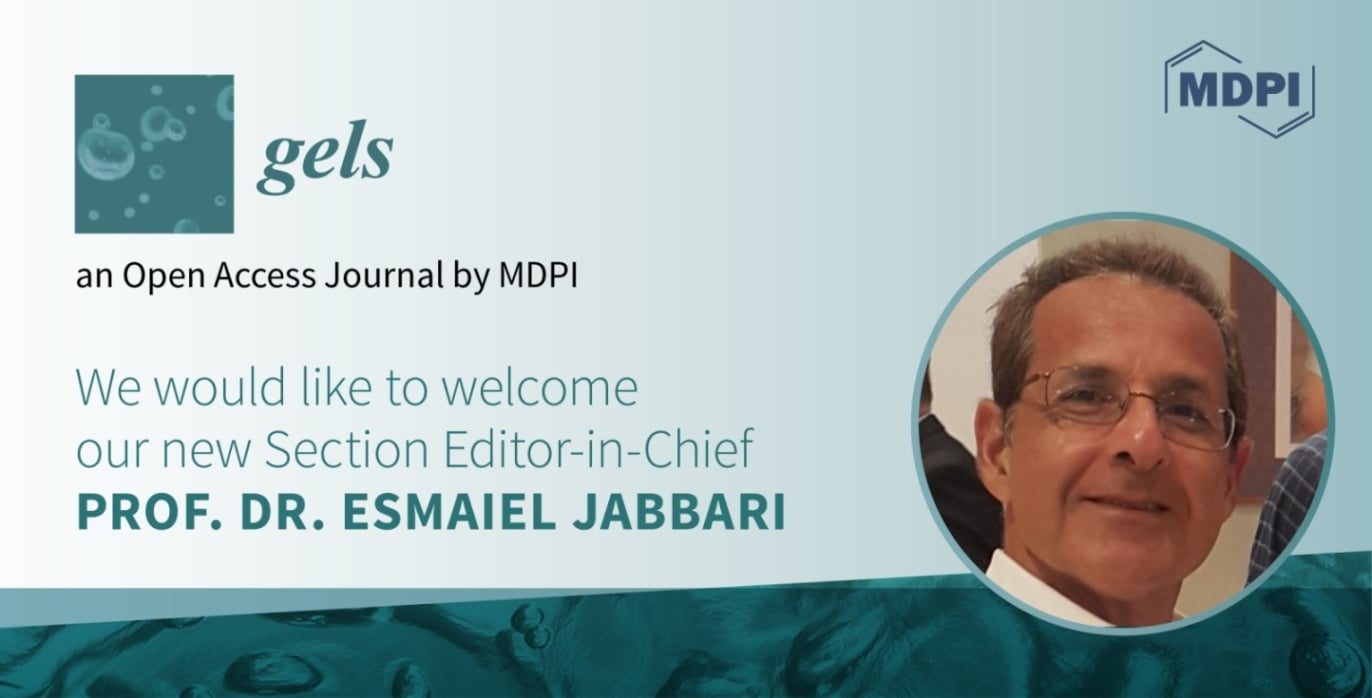
We are pleased to announce that Prof. Dr. Esmaiel Jabbari has been appointed Editor-in-Chief of the Section “Gel Chemistry and Physics” in Gels (ISSN: 2310-2861, IF: 4.432).
Prof. Dr. Esmaiel Jabbari is a tenured full professor of chemical and biomedical engineering at the University of South Carolina. He directs the Biomaterials, Tissue Engineering, and Drug Delivery Laboratory to understand the role of stem cells in tissue maintenance and disease progression by creating 3D multi-cellular soft tissue models and organoids. He received the Berton Rahn Award from AO Foundation, the Stephen Milam Award from the Oral and Maxillofacial Surgery Foundation for his research, and is a Fellow of the American Institute of Medical and Biological Engineering (AIMBE). He has authored more than 130 refereed journal articles and he serves as the Academic Editor for PLOS One and Associate Editor for Gels.
The following is a short Q&A with Prof. Dr. Esmaiel Jabbari, who shared his vision for the Section with us as well as his views on the research area and open access publishing:
1. What appealed to you about the journal that made you want to take the role as its Section Editor-in-Chief?
As I have been conducting research on hydrogels and their application in medicine and pharmacy for the past two decades, the subject of gels, especially their chemistry and physics, is very special to me. The openness of Gels to understanding the chemistry and physics of gels at their fundamental level as well as the applied and product development level appeals to me. The fact that the Section is open to all researchers around the world also appeals to me. The fact that submissions to the Section are reviewed based on the quality of research, not on research results, novelty, or reputation of researchers, is also very important to me.
2. What is your vision for the Section?
My vision for this Section is for it to serve as a platform for researchers around the world for presentation and discussion of the latest advances in chemistry, structure, physics, biology, mathematical modeling and simulation, to all researchers around the world for the purpose of improving people’s quality of life through education and the development of novel gel-based products.
3. What does the future of this field of research look like, in your view?
Gels play a major role in the development of sustainable, biodegradable, environmentally friendly materials to fight global warming as well as other global challenges. There is a need for a greater understanding of the chemistry and physics of self-assembly and structure formation in gels at all scales from molecular to nano-, meso-, micro- and macroscale to design novel gels that meet these challenges.
4. What do you think of the development of open access in the publishing field?
Today’s challenges are not local; they are global. As such, it is important for the message of science to reach all people around the world. Open access allows all people to participate in finding solutions to global challenges.
5. Who should contribute to this Section?
Any researcher who has uncovered, discovered, or observed new and interesting information/phenomena about chemistry, physics, biology, and structure of gels.
21 October 2022
Prof. Dr. Jean-Michel Guenet Appointed Section Editor-in-Chief of Section “Gel Analysis and Characterization” in Gels
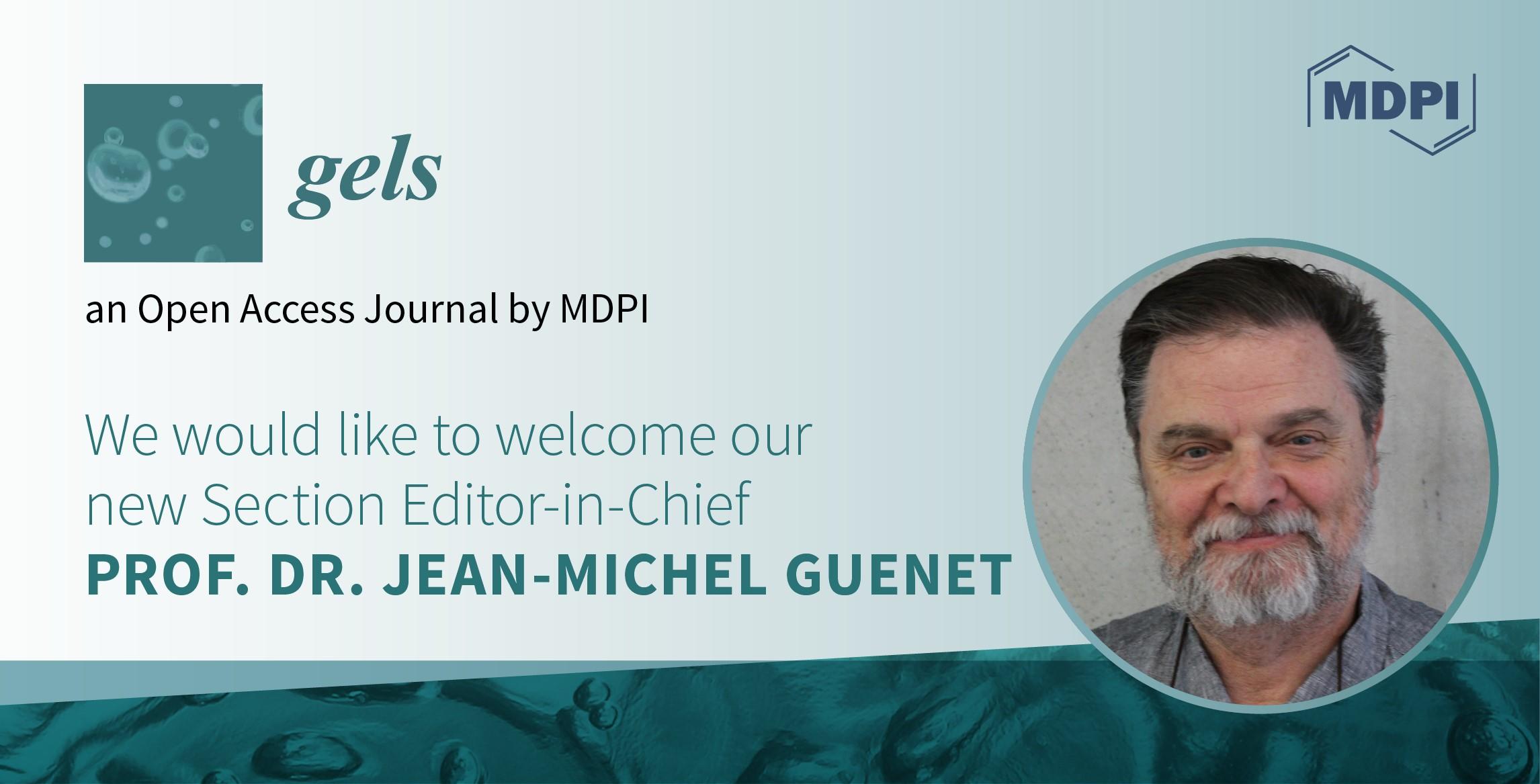
We are pleased to announce that Prof. Dr. Jean-Michel Guenet has been appointed Editor-in-Chief of the Section “Gel Analysis and Characterization” in Gels (ISSN: 2310-2861). Prof. Dr. Jean-Michel Guenet is an emeritus director of research at the CNRS and former director of the Institut Charles Sadron, a CNRS laboratory associated with the University of Strasbourg, devoted to the study and development of polymers and self-assembled systems. He holds a Ph.D. from the University of Strasbourg (formerly Louis Pasteur University) and a degree in materials engineering from the University of Paris. He completed a post-doctoral stay with Prof. A. Keller in Bristol, was a visiting scientist at the NIST in Washington, D.C., and was a visiting professor at Mons University (Belgium) and at the Shizuoka University (Japan).
His research interests span from the study of polymer thermoreversible gelation, polymer-solvent molecular compounds, self-assembled systems, and organogels to hybrid polymer gel/organogel functional materials. He is a specialist in calorimetry (phase diagrams), radiation scattering techniques (neutrons and X-rays), and rheology. He has published about 180 peer-reviewed papers, 3 books (Thermoreversible Gelation of Polymers and Biopolyers, Acad. Press, 1992, Polymer-Solvent Molecular Compounds, Elsevier, 2008, and Organogels: Thermodynamics, Structure, Solvent Role and Properties, Springer, 2016). He has mentored about 30 Ph.D. students and post-doctoral fellows. In 1990 he was awarded the John H. Dillon Medal of the American Physical Society for “distinguished research on polymer chain conformation in semi-crystalline polymers and for major contributions to the understanding of the nature of the gel state”.
The following is a short Q&A with Prof. Dr. Jean-Michel Guenet, who shared his vision for the journal with us, as well as his views of the research area and open access publishing:
1. What appealed to you about the journal that made you want to take the role as its Section Editor-in-Chief?
I am a specialist in polymer thermoreversible gels and organogels. I have written two books on this topic: Thermoreversible Gelation of Polymers and Biopolymers, published in 1992 by the Academic Press, and Organogels: Thermodynamics, Structure, Solvent Role and Properties, published in 2016 by Springer, so it was quite natural for me to become an editor in a journal devoted to gels.
2. What is your vision for the Section?
A Section that will attract more physicists and physical chemists. Indeed, organogels are chiefly studied by chemists, so the deeper physical aspect is often discarded.
3. What does the future of this field of research look like, in your view?
In relation to my answer to question 2, deeper studying and investigation of the physical aspects of the phenomenon.
4. What do you think of the development of Open Access in the publishing field?
I have the feeling that it gradually catches up as traditional journals are now also playing in this field.
5. Who should contribute to this Section?
As suggested by my answers to questions 2 and 3, physicists and physical chemists.
We wish Prof. Dr. Jean-Michel Guenet every success in his new position, and we look forward to his contributions to the journal.
21 October 2022
Dr. Filippo Rossi Appointed Section Editor-in-Chief of Section “Gel Processing and Engineering” in Gels
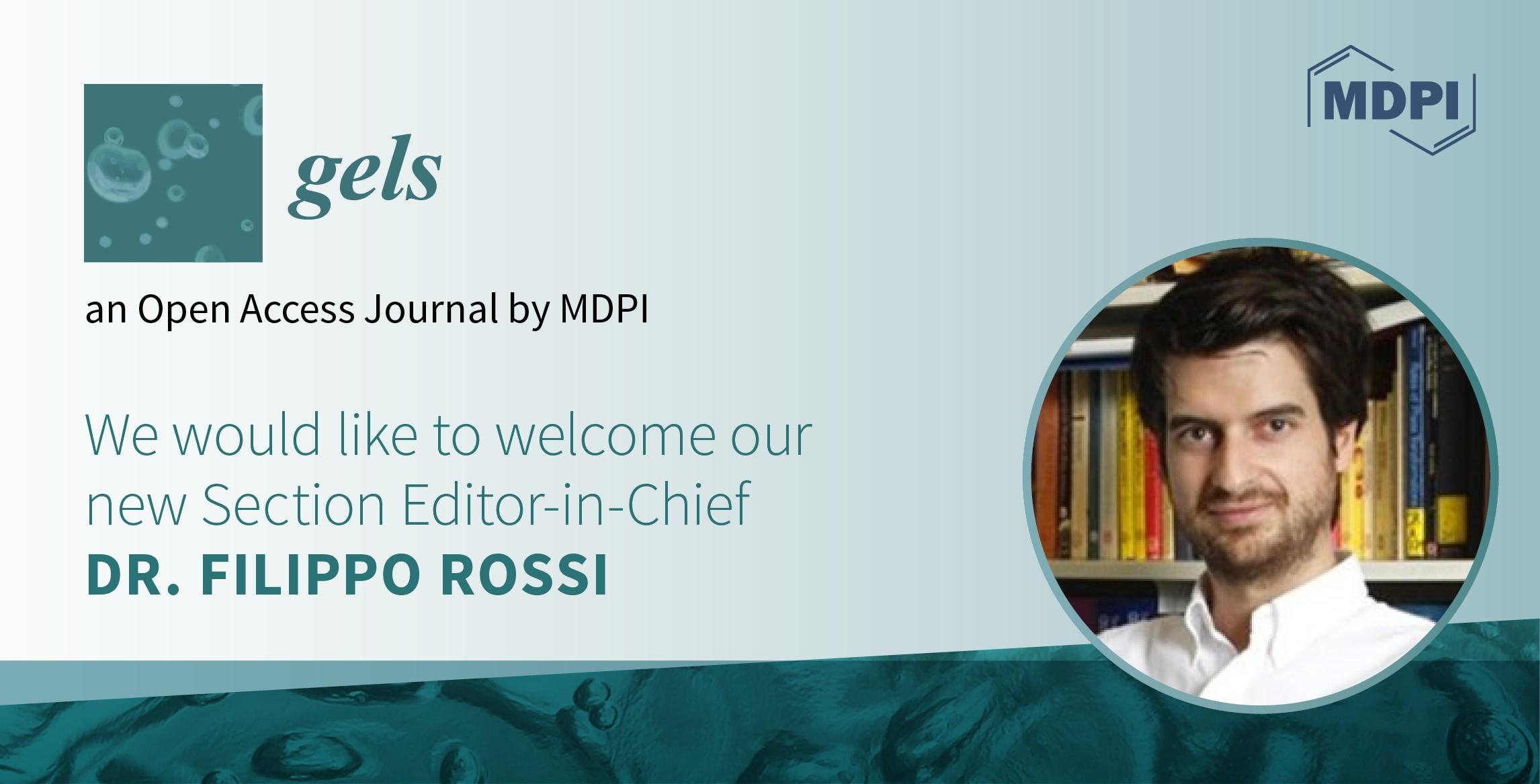
We are pleased to announce that Dr. Filippo Rossi has been appointed Editor-in-Chief of the Section “Gel Processing and Engineering” in Gels (ISSN: 2310-2861, IF: 4.432).
Dr. Filippo Rossi is affiliated with Politecnico di Milano as an associate professor. He completed his Ph.D. in chemical engineering. His research activity is focused on soft materials both on macroscopic and nanoscale, their physicochemical characterization and study of their biological compatibility in vitro and in vivo, together with their ability to control the release of drugs.
In particular, his activity is focused on hydrogels, which can be formed at the site of application from soluble or dispersed precursors through an in-situ gelation process, based on a two-stage cross-linking, firstly physical (aggregation) and then chemical (covalent bond formation).
Moreover, his interests also involve colloidal particles: objects characterized by a sub-micron size and by a kinetic stability towards aggregation provided by an appropriate composition of their surface.
In parallel with his experimental activity, Dr. Filippo Rossi is also involved in two types of model-based studies:
- Modeling, using population balances, of degradation and release rates applied to different biodegradable polymeric medical devices (suture threads, drug eluting stents, micro and nanoparticles);
- Modeling drug transport through hydrogels in a diffusion or superdiffusion regime.
The following is a short Q&A with Dr. Filippo Rossi, who shared his vision for the Section with us as well as his views on the research area and open access publishing:
1. What appealed to you about the journal that made you want to take the role as its Section Editor-in-Chief?
The world of semisolid matrices has developed rapidly in the last ten years, and together with fundamental studies, there is a strong need to discuss technological and scale-up aspects in order to reach the final market.
2. What is your vision for the Section?
I aim for this Section to become the home for all those studies where questions about moving from lab to plants can be discussed together with all the issues associated.
3. What does the future of this field of research look like, in your view?
In my view, the future of the field will be dedicated to all the physicochemical aspects associated with the big production of gel-based materials together with safety concerns and sustainable aspects.
4. What do you think of the development of Open Access in the publishing field?
Open access can definitely improve the knowledge of the entire scientific community.
5. Who should contribute to this Section?
Scientists from academia, research institutions, and industries interested in the investigation of gel-based materials from the lab to the market.
We wish Dr. Filippo Rossi every success in his new position, and we look forward to his contributions to the journal.
18 October 2022
Dr. Miguel A. Cerqueira Appointed Section Editor-in-Chief of Section “Gel Applications” in Gels
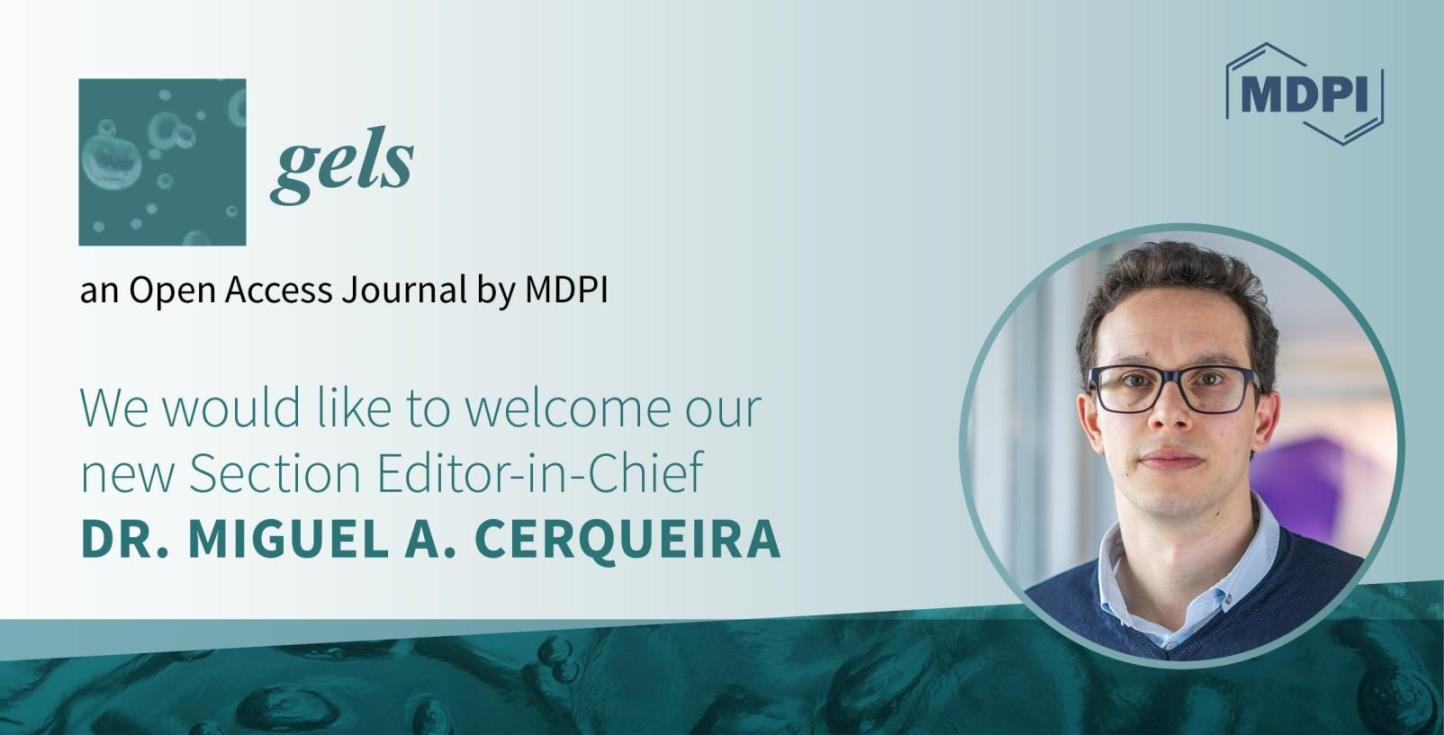
We are pleased to announce that Dr. Miguel A. Cerqueira has been appointed Editor-in-Chief of the Section “Gel Applications” in Gels (ISSN: 2310-2861). Dr. Miguel A. Cerqueira is a Staff Researcher in the Food Processing and Nutrition Group at the International Iberian Nanotechnology Laboratory (INL), and his research is focused on the development of nanosized bio-based structures for food applications. He works on edible and biodegradable films and coatings for packaging, the encapsulation of functional compounds using emergent encapsulation technologies, and the structuring of gels, such as emulgels and oleogels.
Dr. Miguel A. Cerqueira holds a Ph.D. degree in biological engineering from the University of Minho (UM). In 2011, he started as a Postdoctoral Researcher at UM, and in 2016, moved to INL, where he has been working on the development of bio-based micro and nanostructures for different applications. He has been involved in several projects as a principal investigator (PI) and team member, and until now, has raised approximately EUR 5 M in funded projects and contracts with companies. He has authored 145 peer-reviewed scientific articles, published 27 book chapters, 2 patents and is the editor of 4 books (achieving an h‐index of 52). He supervised 13 students (4 Ph.D. and 13 M.Sc.), and at this moment, is the supervisor of 5 Ph.D. students and 3 M.Sc. students. In 2014, he won the Young Scientist Award (sponsored by IUFoST). In 2018, he joined the list of "Highly Cited Researchers" presented by Clarivate Analytics (http://orcid.org/0000-0001-6614-3942).
The following is a short Q&A with Dr. Miguel A. Cerqueira, who shared his vision for the journal with us, as well as his views of the research area and open access publishing:
1. What appealed to you about the journal that made you want to take the role as its Section Editor-in-Chief?
Gels is one of the emergent journals in the field, and since my first contact with the journal as a reader, reviewer and author, the quality of the manuscripts has been increasing, with several top authors submitting their work to the journal. Being Section Editor-in-Chief, I intend to help the journal to publish more interesting work in the field.
2. What is your vision for the Section?
With this Section, I expect to help the authors and readers find some of the most relevant works in the field and help the journal grow.
3. What does the future of this field of research look like, in your view?
Gels can be used in different fields, and therefore, new endeavors and findings are expected in the next few years. The researchers working in universities, research centers and companies are very active in the field, so we can expect brilliant scientific advances in the coming years.
4. What do you think of the development of Open Access in the publishing field?
Opening the research findings to everyone will contribute to the advance of science and technology; therefore, I believe that open access publication is the future of science.
5. Who should contribute to this Section?
All researchers with high-quality work related to gels applications in areas such as biomedical and pharmaceutical, electronics and energy, environment, and food and agriculture.
We wish Dr. Cerqueira every success in his new position, and we look forward to his contributions to the journal.
28 September 2022
Peer Review Week 2022 – Research Integrity: Creating and Supporting Trust in Research
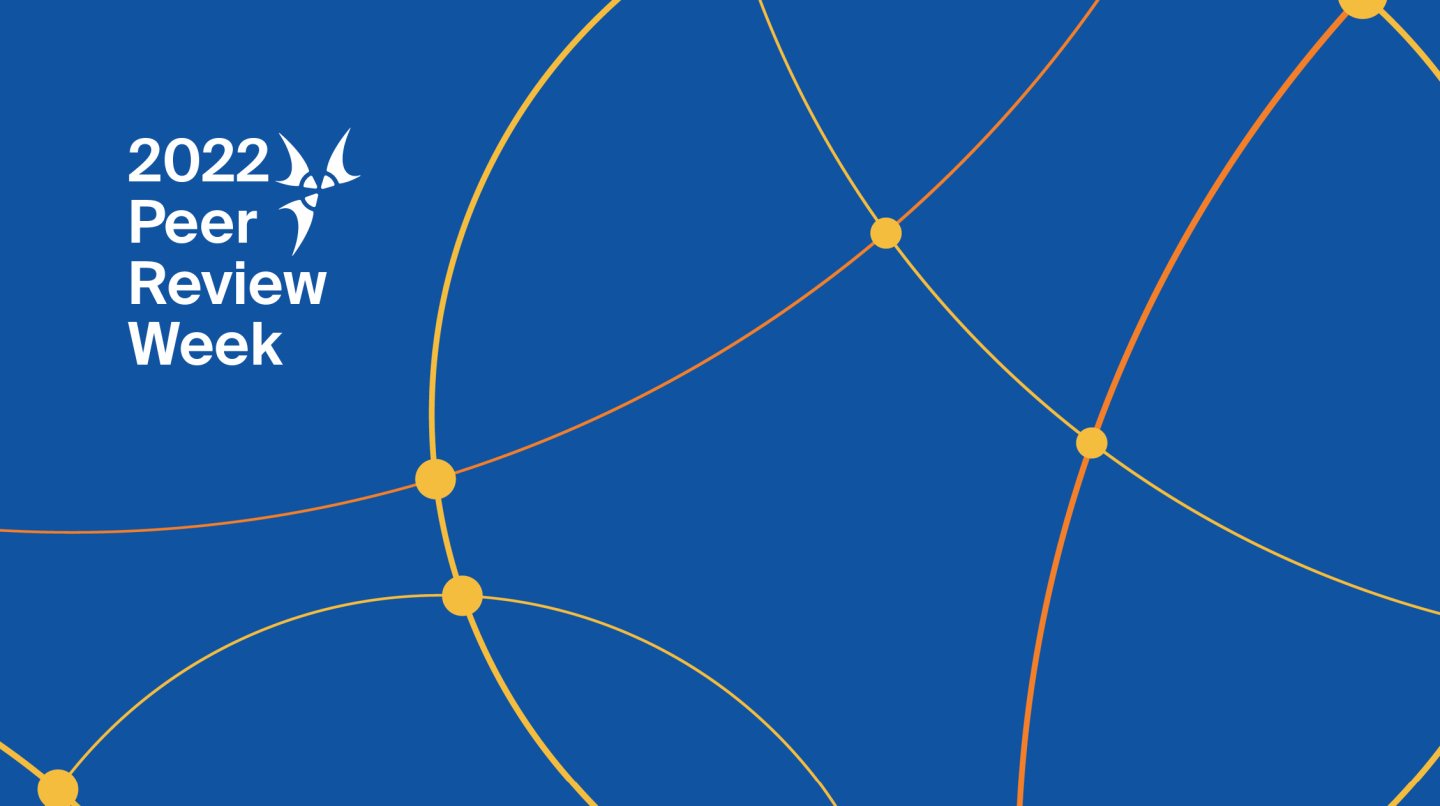
Peer Review Week began 19 September 2022 under the theme of “Research Integrity: Creating and Supporting Trust in Research”. Through various blog articles, podcast, and webinar, we discussed this crucial subject throughout the week, celebrating the essential role peer review plays in maintaining research quality.
To begin, we held a Webinar on the topic. Professor Peter W. Choate and Dr. Emmanuel Obeng-Gyasi joined Dr. Ioana Craciun, one of MDPI’s scientific officers, for an in-depth discussion.
We invite you to view the event recording:
During the week, the MDPI Blog in a series articles highlighted how good Peer Review safeguards research integrity. The following topics were covered:
- Peer Review Week 2022
- Research Integrity
- What We’ve Learned About Peer Review Reports
- 4 Steps to the Perfect Peer Review Report
- How to Write the Perfect Peer Review Report: An Interview
- Inviting Great Peer Reviewers
In a new edition of Insight Faster, an MDPI podcast, we were delighted to talk to the co-chairs of the Peer Review Week committee, Jayashree Rajagopalan (Senior Manager of Global Community Engagement for CACTUS) and Danielle Padula (Head of Marketing and Community Development at Scholastica) to get their take on this year’s event and its related topics.
You can find the Podcast here.
We hope you enjoy the contents!
27 September 2022
Gels | Top 10 Cited Papers in 2021
1. “Thermo-Responsive Hydrogels: From Recent Progress to Biomedical Applications”
by Kaiwen Zhang et al.
Gels 2021, 7(3), 77; https://www.mdpi.com/2310-2861/7/3/77
Available online: https://www.mdpi.com/2310-2861/7/3/77
2. “Cellulose-Based Hydrogels for Wastewater Treatment: A Concise Review”
by Maimuna Akter et al.
Gels 2021, 7(1), 30; https://www.mdpi.com/2310-2861/7/1/30
Available online: https://www.mdpi.com/2310-2861/7/1/30
3. “Synthesis of Nanogels: Current Trends and Future Outlook”
by Emanuele Mauri et al.
Gels 2021, 7(2), 36; https://www.mdpi.com/2310-2861/7/2/36
Available online: https://www.mdpi.com/2310-2861/7/2/36
4. “Oleogel-Based Systems for the Delivery of Bioactive Compounds in Foods”
by Tiago C. Pinto et al.
Gels 2021, 7(3), 86; https://www.mdpi.com/2310-2861/7/3/86
Available online: https://www.mdpi.com/2310-2861/7/3/86
5. “Hydrogels Classification According to the Physical or Chemical Interactions and as Stimuli-Sensitive Materials”
by Moises Bustamante-Torres et al.
Gels 2021, 7(4), 182; https://www.mdpi.com/2310-2861/7/4/182
Available online: https://www.mdpi.com/2310-2861/7/4/182
6. “Recently Developed Carbohydrate Based Gelators and Their Applications”
by Joedian Morris et al.
Gels 2021, 7(1), 24; https://www.mdpi.com/2310-2861/7/1/24
Available online: https://www.mdpi.com/2310-2861/7/1/24
7. “Tunable Human Myocardium Derived Decellularized Extracellular Matrix for 3D Bioprinting and Cardiac Tissue Engineering”
by Gozde Basara et al.
Gels 2021, 7(2), 70; https://www.mdpi.com/2310-2861/7/2/70
Available online: https://www.mdpi.com/2310-2861/7/2/70
8. “Fabrication and Characterization of Diclofenac Sodium Loaded Hydrogels of Sodium Alginate as Sustained Release Carrier”
by Muhammad Suhail et al.
Gels 2021, 7(1), 10; https://www.mdpi.com/2310-2861/7/1/10
Available online: https://www.mdpi.com/2310-2861/7/1/10
9. “Preparation, Optimization and Evaluation of Chitosan-Based Avanafil Nanocomplex Utilizing Antioxidants for Enhanced Neuroprotective Effect on PC12 Cells”
by Mallesh Kurakula et al.
Gels 2021, 7(3), 96; https://www.mdpi.com/2310-2861/7/3/96
Available online: https://www.mdpi.com/2310-2861/7/3/96
10. “Nanogels as a Versatile Drug Delivery System for Brain Cancer”
by Brielle Stawicki et al.
Gels 2021, 7(2), 63; https://www.mdpi.com/2310-2861/7/2/63
Available online: https://www.mdpi.com/2310-2861/7/2/63
20 July 2022
Meet Us at the 49th World Polymers Congress MACRO 2022, 17–21 July 2022, Winnipeg, Canada
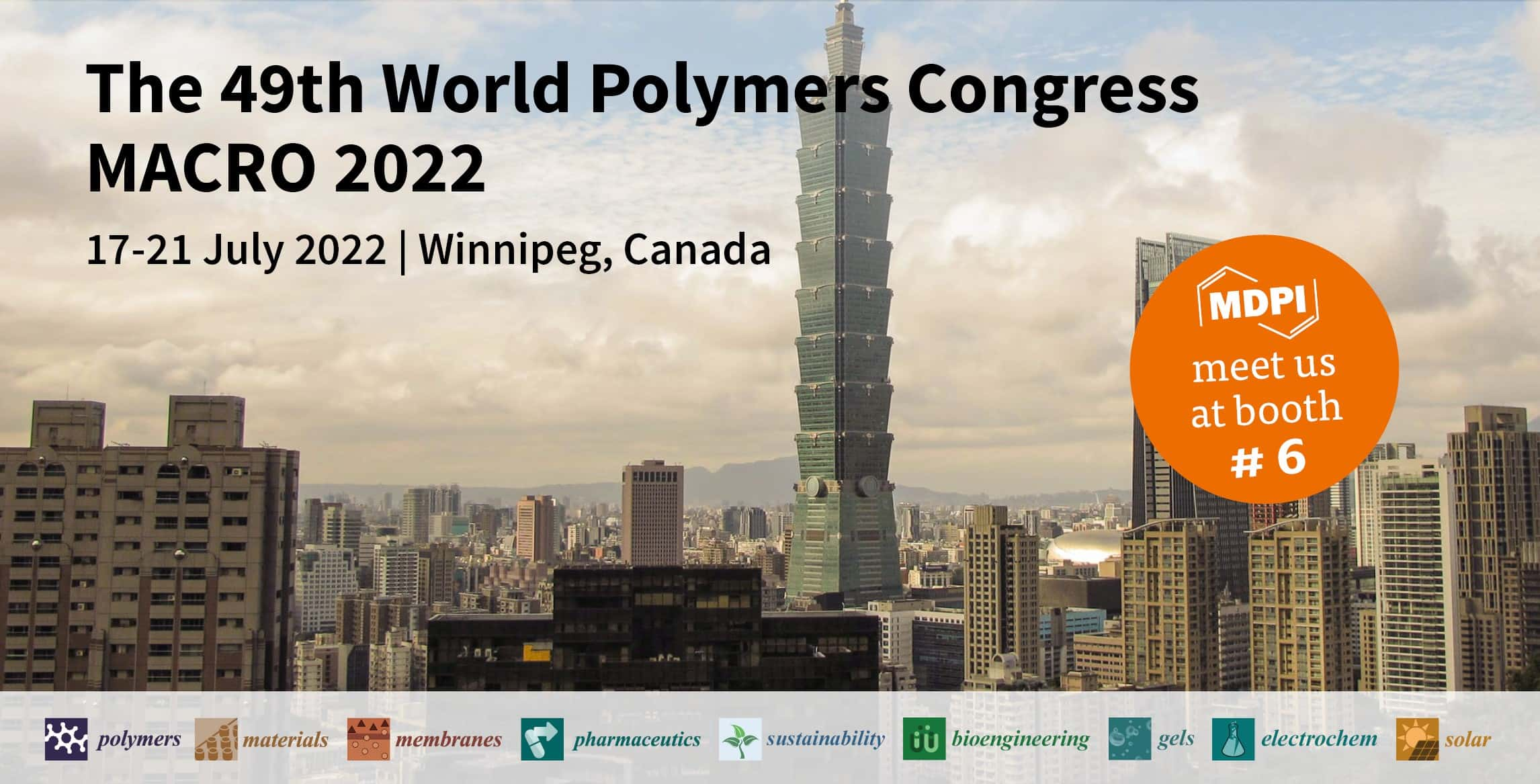
Conference: 49th World Polymers Congress MACRO 2022
Date: 17–21 July 2022
Place: Winnipeg, Canada
Booth: #6
Polymers (ISSN: 2073-4360) and Materials (ISSN: 1996-1944) will be attending the 49th World Polymers Congress MACRO 2022 as exhibitors from 17 to 21 July 2022 in Winnipeg, Canada.
The year 2022 marks the first time that Canada is hosting the World Polymers Congress since it became a biennial event in 1998. The polymer science community of Canada looks forward to connecting at the 49th World Polymers Congress, which is held in the city of Winnipeg from 17 to 21 July 2022. True to its mission, MACRO 2022 will be a forum for international scientists and students who are in various stages of their career development to share knowledge and experiences.
The MACRO 2022 program comprises nine themes that represent the following subjects:
- Polymers for Biomedical Engineering;
- Polymers for Energy and Environmental Applications;
- Polymer Engineering and Rheology;
- Polymers for Nanotechnology;
- Polymer Physics and Characterization;
- Polymers from Renewable Resources and Biodegradable Polymers;
- Polymer Science Education;
- Polymer Synthesis and Kinetics;
- Smart and Functional Polymers.
The following MDPI journals will be represented:
- Polymers;
- Materials;
- Membranes;
- Pharmaceutics;
- Sustainability;
- Bioengineering;
- Gels;
- Electrochem;
- Solar.
Please do not hesitate to reach out if you plan on attending this conference. Our delegates look forward to meeting you in person and answering any questions that you might have.
For more information about the conference, please visit the following website: https://www.macro2022.org/.
28 June 2022
2021 Impact Factors - Released
The 2021 citation metrics have been released in the Journal Citation Reports (JCR), and we’re pleased to announce the following results for MDPI journals:

| Journal | Impact Factor | Rank | Category |
| Antioxidants | 7.675 | Q1 | Food Science & Technology |
| Biochemistry & Molecular Biology | |||
| Chemistry, Medicinal | |||
| Cells | 7.666 | Q2 | Cell Biology |
| Nutrients | 6.706 | Q1 | Nutrition & Dietetics |
| Cancers | 6.575 | Q1 | Oncology |
| Pharmaceutics | 6.525 | Q1 | Pharmacology & Pharmacy |
| International Journal of Molecular Sciences | 6.208 | Q1 | Biochemistry & Molecular Biology |
| Q2 | Chemistry, Multidisciplinary | ||
| Marine Drugs | 6.085 | Q1 | Chemistry, Medicinal |
| Pharmacology & Pharmacy | |||
| Biomolecules | 6.064 | Q2 | Biochemistry & Molecular Biology |
| Batteries * | 5.938 | Q2 | Electrochemistry |
| Energy & Fuels | |||
| Materials Science, Multidisciplinary | |||
| Viruses | 5.818 | Q2 | Virology |
| Biosensors | 5.743 | Q1 | Chemistry, Analytical |
| Instruments & Instrumentation | |||
| Q2 | Nanoscience & Nanotechnology | ||
| Journal of Fungi | 5.724 | Q1 | Mycology |
| Q2 | Microbiology | ||
| Nanomaterials | 5.719 | Q1 | Physics, Applied |
| Q2 | Chemistry, Multidisciplinary | ||
| Materials Science, Multidisciplinary | |||
| Nanoscience & Nanotechnology | |||
| Metabolites | 5.581 | Q2 | Biochemistry & Molecular Biology |
| Foods | 5.561 | Q1 | Food Science & Technology |
| Drones * | 5.532 | Q2 | Remote Sensing |
| Remote Sensing | 5.349 | Q1 | Geosciences, Multidisciplinary |
| Imaging Science & Photographic Technology | |||
| Q2 | Remote Sensing | ||
| Environmental Sciences | |||
| Journal of Theoretical and Applied Electronic Commerce Research | 5.318 | Q2 | Business |
| Antibiotics | 5.222 | Q1 | Pharmacology & Pharmacy |
| Q2 | Infectious Diseases | ||
| Pharmaceuticals | 5.215 | Q1 | Pharmacology & Pharmacy |
| Q2 | Chemistry, Medicinal | ||
| Biology | 5.168 | Q1 | Biology |
| Fermentation | 5.123 | Q2 | Biotechnology & Applied Microbiology |
| Toxins | 5.075 | Q1 | Toxicology |
| Q2 | Food Science & Technology | ||
| Bioengineering * | 5.046 | Q2 | Engineering, Biomedical |
| Polymers | 4.967 | Q1 | Polymer Science |
| Journal of Clinical Medicine | 4.964 | Q2 | Medicine, General & Internal |
| Vaccines | 4.961 | Q2 | Immunology |
| Medicine, Research & Experimental | |||
| Molecules | 4.927 | Q2 | Chemistry, Multidisciplinary |
| Biochemistry & Molecular Biology | |||
| Microorganisms | 4.926 | Q2 | Microbiology |
| Journal of Functional Biomaterials * | 4.901 | Q2 | Engineering, Biomedical |
| Materials Science, Biomaterials | |||
| Biomedicines | 4.757 | Q2 | Medicine, Research & Experimental |
| Pharmacology & Pharmacy | |||
| Biochemistry & Molecular Biology | |||
| Plants | 4.658 | Q1 | Plant Sciences |
| International Journal of Environmental Research and Public Health | 4.614 | Q1 | Public, Environmental & Occupational Health (SSCI) |
| Q2 | Public, Environmental & Occupational Health (SCIE) | ||
| Environmental Sciences (SCIE) | |||
| Membranes | 4.562 | Q1 | Polymer Science |
| Q2 | Engineering, Chemical | ||
| Materials Science, Multidisciplinary | |||
| Chemistry, Physical | |||
| Pathogens | 4.531 | Q2 | Microbiology |
| Catalysts | 4.501 | Q2 | Chemistry, Physical |
| Toxics | 4.472 | Q2 | Toxicology |
| Environmental Sciences | |||
| Gels | 4.432 | Q1 | Polymer Science |
| Journal of Cardiovascular Development and Disease | 4.415 | Q2 | Cardiac & Cardiovascular Systems |
| Chemosensors | 4.229 | Q1 | Instruments & Instrumentation |
| Q2 | Chemistry, Analytical | ||
| Q3 | Electrochemistry | ||
| Genes | 4.141 | Q2 | Genetics & Heredity |
| Diagnostics | 3.992 | Q2 | Medicine, General & Internal |
| Agronomy | 3.949 | Q1 | Agronomy |
| Plant Sciences | |||
| Land | 3.905 | Q2 | Environmental Studies |
| Sustainability | 3.889 | Q2 | Environmental Sciences (SCIE) |
| Environmental Studies (SSCI) | |||
| Q3 | Green & Sustainable Science & Technology (SCIE) | ||
| Q4 | Green & Sustainable Science & Technology (SSCI) | ||
| Sensors | 3.847 | Q2 | Instruments & Instrumentation |
| Chemistry, Analytical | |||
| Engineering, Electrical & Electronic | |||
| Materials | 3.748 | Q1 | Metallurgy & Metallurgical Engineering |
| Q2 | Physics, Applied | ||
| Physics, Condensed Matter | |||
| Q3 | Materials Science, Multidisciplinary | ||
| Chemistry, Physical | |||
| Biomimetics * | 3.743 | Q2 | Engineering, Multidisciplinary |
| Q3 | Materials Science, Biomaterials | ||
| Tropical Medicine and Infectious Disease * | 3.711 | Q1 | Tropical Medicine |
| Q2 | Parasitology | ||
| Q3 | Infectious Diseases | ||
| Lubricants * | 3.584 | Q2 | Engineering, Mechanical |
| Fractal and Fractional | 3.577 | Q1 | Mathematics, Interdisciplinary Applications |
| Water | 3.530 | Q2 | Water Resources |
| Q3 | Environmental Sciences | ||
| Micromachines | 3.523 | Q2 | Instruments & Instrumentation |
| Physics, Applied | |||
| Chemistry, Analytical | |||
| Q3 | Nanoscience & Nanotechnology | ||
| Journal of Personalized Medicine | 3.508 | Q2 | Medicine, General & Internal |
| Health Care Sciences & Services | |||
| Agriculture | 3.408 | Q1 | Agronomy |
| Processes | 3.352 | Q2 | Engineering, Chemical |
| Separations | 3.344 | Q2 | Chemistry, Analytical |
| Magnetochemistry | 3.336 | Q2 | Chemistry, Inorganic & Nuclear |
| Q3 | Chemistry, Physical | ||
| Materials Science, Multidisciplinary | |||
| Brain Sciences | 3.333 | Q3 | Neurosciences |
| Buildings | 3.324 | Q2 | Construction & Building Technology |
| Engineering, Civil | |||
| Forests | 3.282 | Q1 | Forestry |
| Energies | 3.252 | Q3 | Energy & Fuels |
| Life | 3.251 | Q2 | Biology |
| Coatings | 3.236 | Q2 | Materials Science, Coatings & Films |
| Physics, Applied | |||
| Q3 | Materials Science, Multidisciplinary | ||
| Animals | 3.231 | Q1 | Agriculture, Dairy & Animal Science |
| Veterinary Sciences | |||
| Journal of Intelligence * | 3.176 | Q2 | Psychology, Multidisciplinary |
| Fishes | 3.170 | Q1 | Marine & Freshwater Biology |
| Q2 | Fisheries | ||
| Healthcare | 3.160 | Q2 | Health Policy & Services (SSCI) |
| Health Care Sciences & Services (SCIE) | |||
| Inorganics * | 3.149 | Q2 | Chemistry, Inorganic & Nuclear |
| Insects | 3.139 | Q1 | Entomology |
| Atmosphere | 3.110 | Q3 | Meteorology & Atmospheric Sciences |
| Environmental Sciences | |||
| Current Oncology | 3.109 | Q3 | Oncology |
| ISPRS International Journal of Geo-Information | 3.099 | Q2 | Geography, Physical |
| Q3 | Computer Science, Information Systems | ||
| Remote Sensing | |||
| Diversity | 3.029 | Q2 | Biodiversity Conservation |
| Ecology | |||
| Tomography | 3.000 | Q3 | Radiology, Nuclear Medicine & Medical Imaging |
| Current Issues in Molecular Biology | 2.976 | Q3 | Biochemistry & Molecular Biology |
| Medicina | 2.948 | Q3 | Medicine, General & Internal |
| Symmetry | 2.940 | Q2 | Multidisciplinary Sciences |
| Horticulturae | 2.923 | Q1 | Horticulture |
| Machines | 2.899 | Q2 | Engineering, Mechanical |
| Engineering, Electrical & Electronic | |||
| Systems * | 2.895 | Q2 | Social Sciences, Interdisciplinary |
| Applied Sciences | 2.838 | Q2 | Engineering, Multidisciplinary |
| Physics, Applied | |||
| Q3 | Chemistry, Multidisciplinary | ||
| Materials Science, Multidisciplinary | |||
| Children | 2.835 | Q2 | Pediatrics |
| Minerals | 2.818 | Q2 | Mining & Mineral Processing |
| Mineralogy | |||
| Geochemistry & Geophysics | |||
| Universe | 2.813 | Q2 | Astronomy & Astrophysics |
| Q3 | Physics, Particles & Fields | ||
| Journal of Marine Science and Engineering | 2.744 | Q1 | Engineering, Marine |
| Q2 | Oceanography | ||
| Engineering, Ocean | |||
| Entropy | 2.738 | Q2 | Physics, Multidisciplinary |
| Fire * | 2.726 | Q2 | Forestry |
| Q3 | Ecology | ||
| Metals | 2.695 | Q2 | Metallurgy & Metallurgical Engineering |
| Q3 | Materials Science, Multidisciplinary | ||
| Electronics | 2.690 | Q3 | Engineering, Electrical & Electronic |
| Computer Science, Information Systems | |||
| Physics, Applied | |||
| Crystals | 2.670 | Q2 | Crystallography |
| Q3 | Materials Science, Multidisciplinary | ||
| Aerospace | 2.660 | Q1 | Engineering, Aerospace |
| Mathematics | 2.592 | Q1 | Mathematics |
| Photonics | 2.536 | Q3 | Optics |
| Actuators | 2.523 | Q2 | Instruments & Instrumentation |
| Q3 | Engineering, Mechanical | ||
| Veterinary Sciences | 2.518 | Q2 | Veterinary Sciences |
| Behavioral Sciences * | 2.286 | Q3 | Psychology, Multidisciplinary |
| Axioms * | 1.824 | Q2 | Mathematics, Applied |
For more information on Impact Factors and what it means to index academic journals, please visit our related blog posts.
* Journals given their first Impact Factor in 2022
Source: 2021 Journal Impact Factors, Journal Citation Reports TM (Clarivate, 2022)
27 June 2022
Welcoming New Editorial Board Members of Gels
We are pleased to announce that the following five scholars have recently been appointed Editorial Board Members for the journal Gels (ISSN: 2310-2861):
- Dr. Hiroyuki Takeno (Gunma University);
- Prof. Dr. Baojun Bai (Missouri University of Science and Technology);
- Prof. Dr. Hiroyuki Ohshima (Tokyo University of Science);
- Dr. Jun Li (National University of Singapore);
- Prof. Dr. Benzhong Tang (The Chinese University of Hong Kong).
We wish them every success in developing the journal.
Further details about the Editorial Board can be found at the following website: https://www.mdpi.com/journal/gels/editors.




